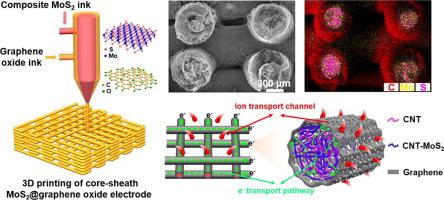Chemical Engineering Journal ( IF 13.3 ) Pub Date : 2021-05-13 , DOI: 10.1016/j.cej.2021.130304 Zhengpeng Yang , Xiaoting Lv , Chunjing Zhang , Yongyi Zhang , Shengmin Jia , Yutao Niu , Yichi Zhang , Bin Wang , Tian Zhao , Huili Fu , Qingwen Li

|
Pseudocapacitance holds great promise for energy density improvement of supercapacitors. However, how to enable a pseudocapacitor with combined feature of high mass loading of pseudocapacitive material, efficient ion/electron transport, as well as facile and scalable manufacturing, still remains a significant challenge. Herein, we demonstrated an efficient and scalable extrusion-based core-sheath 3D printing strategy for directly and controllably constructing pseudocapacitive carbon nanotube (CNT)- MoS2 (CM)-CNT/graphene electrode, with high mass loading up to 55% and uniform distribution of MoS2, hierarchically porous configuration and highly interconnected conductive network framework built by coupling graphene scaffold located in shell layer and CNTs situated in core layer. The unique architecture featuring adequate channels and pathways can act as a “superhighway” for ultrafast ion diffusion and electron transport throughout the entire device, thereby enabling fast kinetics of Faradaic reactions and abundant availability of electrochemical active sites. A symmetric pseudocapacitor assembled with 3D-printed electrode and in situ electrospun poly(vinylidene fluoride) (PVDF) nanofiber separator delivered high specific capacitance (558 mF cm-2) and energy density (49 µWh cm-2), remarkable cycling stability (87% after 8000 cycles), and superior capacity even at large electrode thickness. This work has shed light on new strategies for designing and fabricating high-performance pseudocapacitors toward future uses.
中文翻译:

具有伪电容特性的高导电MoS 2负载电极的芯鞘3D打印
伪电容对于改善超级电容器的能量密度具有广阔的前景。然而,如何使伪电容器具有伪电容器材料的大量负载,有效的离子/电子传输以及简便且可扩展的制造的组合特征仍然是一个重大挑战。在本文中,我们展示了一种有效且可扩展的基于挤压的芯鞘3D打印策略,可直接可控地构建假电容碳纳米管(CNT )-MoS 2(CM)-CNT /石墨烯电极,具有高达55%的高质量负载且均匀MoS 2的分布,通过耦合位于壳层的石墨烯支架和位于芯层的CNT构建分层多孔结构和高度互连的导电网络框架。具有足够通道和路径的独特体系结构可以充当“高速公路”,在整个设备中实现超快的离子扩散和电子传输,从而实现法拉第反应的快速动力学和丰富的电化学活性位。由3D打印电极和原位电纺聚偏二氟乙烯(PVDF)纳米纤维隔板组装而成的对称伪电容器可提供高比电容(558 mF cm -2)和能量密度(49 µWh cm -2)),出色的循环稳定性(8000次循环后为87%),即使在较大的电极厚度下也具有出色的容量。这项工作为设计和制造面向未来用途的高性能伪电容器提供了新的策略。











































 京公网安备 11010802027423号
京公网安备 11010802027423号